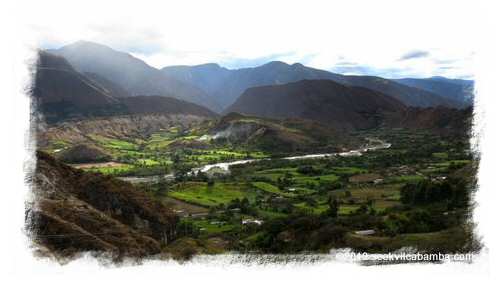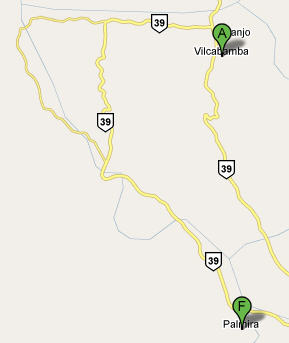A day in Quinara
by Anita Evans

Head south from Vilcabamba along the main road; you will travel along mountain roads.
At one point you look up this mountain face and you feel like an ant. You come to
a faded sign on your right that says ‘entrada Quinara’ turn right here!
You will now be on unsealed road. Thought you would have gone through some segments
of unsealed road on the main road you have just turned off. However, from now on
in it is totally unsealed.
Follow this one lane road till you come across a very very nice new red and grey
painted metal bridge (on your left). It’s totally out of place given it’s in the
middle of nowhere. At the bridge the road in front of you forks. Take the right
fork. At the time of writing this the left fork was ‘no pasa’.
Again, follow the one lane dirt road and you will eventually come out on top of
a very lush green river belt with little villages and casa’s dotted along the rivers
shores. Follow the road down the hill (well there is nowhere else for you to go,
really) and you will arrive at the village of Quinara. The people are very friendly
here. The town itself does not flow as well as Vilcabamba in fact it’s completely
different to Vilcabamba. It’s smaller and obviously not a tourist attraction that
Vilcabamba has come to be.
You could go down the river and stop for a while and enjoy your picnic. Or ask the
locals for La Palmira. They will tell you to go across the suspended bridge and
follow the road. This is another impressive bridge given the look of the area around
you. It’s a long, red metal bridge in very good condition (at the time of writing).
If you decide to go across the suspended bridge to La Palmira you will enjoy a nice
drive through some very typical villages of Ecuador. The road is bordered by a very
nice tapia wall on the left which is adorned with bougainvilla plants. It separates
the cane fields from the road and I suspect keeps the dust off the cane and the
people out. Cane is the main crop in this area. If you go along far enough, crossing
the river you’ll come to some cliff faces that are made up of pink and red rock.
It is just after this point that we turned around and headed back.

From Quinara you can take a different road back to Vilcabamba. The instructions
I were given was when you come in to Quinara from your trip from the main road turn
right on the main road in Quinara and that road will end up by Hosteria Vilcabamba.
Or just ask a local to point you in the direction of Vilcabamba.
Be fair warned……….. this is a dirt road, one lane in most parts. Quite often there
is no one to be seen (we didn’t pass a single car until we got just outside of Vilcabamba).
There is no gas station. It’s a LONG drive back along this road.
The trip is very scenic. The road follows a river and goes through some small settlements.
Just follow the road…. You will come to one settlement that has a very small town
square surrounded by some half kept hedges take the left fork in the road here.
Or ask a local for the good road to Vilcabamba. DON”T take the road that goes past
the basketball concrete (will be on your left as you leave the village if you are
on this road) area as this is the bad road to Vilcabamba.
Now keep following and following the road. You may experience moments where you
wonder where the hell you are as you watch your gas tank needle go down and dusk
set in. At a point in time you will come across a very fancy house with stables
and white fences. You’ll know it as it stands out from anything else you will have
passed along the way. The road turns right at this point. You are now on the road
that will take you to Hosteria Vilcabamba. The river is still on your left but following
a different way now. As you follow this road the settlements will become denser
and the road will turn to a sealed road. At the very end you will find yourself
at the main road into Vilcabamba with Hosteria Vilcabamba on your right.
This is a long drive 1 hour to 1 ½ hours plus.
It is a nice day trip and allows you to see rural Ecuador and some nice scenery.
You will see Vilcabamba with new eyes.
Zaruma